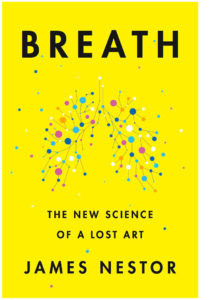Breath
Full Title: Breath: The New Science of a Lost Art
Author / Editor: James Nestor
Publisher: Riverhead Books, 2020
Review © Metapsychology Vol. 24, No. 43
Reviewer: Beth Cholette, Ph.D.
In this book, author James Nestor takes a deep dive into the seemingly simple subject of breath. He creates a compelling argument for the old adage “breath is life.” In his Introduction, Nestor calls pioneers in the study of breathing “pulmonauts.” Members of eclectic group from various backgrounds independently came to the mutual conclusion that breath manipulation—often in ways unconventional and even contrary to science—was useful and beneficial.
Part One of Breath opens with “The Experiment.” Nestor reports that he and another volunteer agreed to have their nasal passages blocked so that they became “mouth-breathers,” taking in oxygen through the nose only as they moved through their everyday lives. A second, later phase involved switching to nose-exclusive breathing, this time while practicing specific breath techniques. Nestor maintains that humans shifted to increased use of mouth-breathing relatively recently in our evolutionary history, much to our detriment. He describes in detail the negative impact of his own mouth-breathing experiment, which resulted in chronic sleep apnea. After the process is reversed, Nestor reviews the crucial role of the nose, not only in breathing but also in whole-body health. The importance of breathing solely through the nose is emphasized to the extent that taping the mouth shut at night is recommended.
To support his assertions, Nestor offers a historical perspective. He travelled the world to interview scientists, view human skulls, and identify success stories, such as Olympic sprinter Lee Evans. He discovered what he calls “a gap in our knowledge about the science of breathing and its role in our bodies” (p. 72), and he eventually arrives at the conclusion that what our bodies need is more carbon dioxide (p. 75). In other words, Nestor postulates that the key to better breathing is not more breath but slower breathing, which creates a more desirable balance between oxygen and carbon dioxide. By studying several different prayer traditions (Hindu, Taoist, and Native American), he determines that the ideal rate of breathing is 5.5 breaths per minute. He further argues that we’ve become “a culture of overbreathers” (p. 86) and maintains that the “fix” is to breathe less.
The research behind this conclusion stems from a collection of sources, including a renegade treatment of asthma patients. Although Nestor provides impressive anecdotal evidence (including his case study of himself), he never fully clarifies why the breathing less practice is not more widely taught. Instead, he shifts to the importance of chewing, explaining how our transition to a softer food diet has led humans to experience greater respiratory issues. He describes an early orthodontic device, the “monobloc,” which was designed to widen the mouth (rather than straightening the teeth), thus compensating for the ravages of evolution. Furthermore, he maintains that contemporary dentistry is just beginning to acknowledge the devastating impact of today’s orthodontic apparatus on the breath.
The last third of the book, “Breathing+,” centers around specific breathing techniques, with the caveat that these breath exercises do not follow the “breathe less” rule. Furthermore, Nestor specifically warns that these practices are not accessible to everyone and not easy to learn, calling them “extreme techniques” (p. 140). Again, Nestor delves into an exploration of fringe methods that are supported largely by non-scientific evidence. One such strategy, The Inner Fire Meditation or Tummo, is derived from Tibetan Buddhism. Nestor attests that he has seen “dozens” benefit from this method (p. 148) while acknowledging that scientists don’t really understand why it would be effective. However, Nestor cites modern proponents, such as extreme athlete Wim Hof, as having popularized this type of controlled hyperventilation. In addition to faster breathing, Nestor explores holding the breath. He reviews experiments using inhaled carbon dioxide as a means to treat anxiety, again using himself as a subject. As with the other practices presented in this book, Nestor notes that this technique has been around for thousands of years. In the final chapter, he recounts another ancient practice as he details the association between breathwork and yoga.
In the Epilogue, Nestor summarizes his findings in the form of basic recommendations for improved breathing. These include the following directives: shut your mouth, breathe through your nose, exhale, and chew, plus the added suggestions to “breathe more, on occasion” and to “hold your breath.” The Appendix includes the breathing methods presented elsewhere in the book (e.g., alternate nostril breathing) and introduces some additional breathing methods that “didn’t make the cut in the main text” (p. 228) although Nestor reports regularly practicing them (as do I, as they are common breathwork practices in yoga). The book concludes with over forty pages of chapter notes.
Nestor shares his vision of a future in which a significant emphasis is placed on the power of breathing to improve health. As our knowledge about critical anatomical structures such as the vagus nerve improves, we may yet discover that breath is a natural, built-in remedy. Still, much further research is needed in this area in order for these practices to be adopted into the healthcare mainstream.
Beth Cholette, Ph.D., is a clinical psychologist who provides psychotherapy to college students.
Categories: Wellness
Keywords: breath, wellness

